Hypoperfusion shock - Study guides, Class notes & Summaries
Looking for the best study guides, study notes and summaries about Hypoperfusion shock? On this page you'll find 1400 study documents about Hypoperfusion shock.
Page 4 out of 1.400 results
Sort by
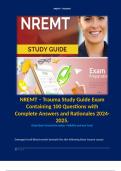
-
NREMT – Trauma Study Guide Exam Containing 100 Questions with Complete Answers and Rationales 2024-2025.
- Exam (elaborations) • 91 pages • 2024
- Available in package deal
-
- $13.19
- + learn more
NREMT – Trauma Study Guide Exam Containing 100 Questions with Complete Answers and Rationales . Contains Terms like: Damaged small blood vessels beneath the skin following blunt trauma causes: A: mottling. B: ecchymosis. C: hematoma. D: cyanosis. - Answer: B; Rationale: When small blood vessels beneath the skin are damaged, blood seeps into the soft tissues. This manifests as a bruise, also referred to as ecchymosis. A hematoma develops when larger blood vessels are ruptured ...
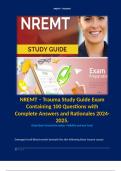
-
NREMT – Trauma Study Guide Exam Containing 100 Questions with Complete Answers and Rationales 2024-2025.
- Exam (elaborations) • 91 pages • 2024
- Available in package deal
-
- $13.09
- + learn more
NREMT – Trauma Study Guide Exam Containing 100 Questions with Complete Answers and Rationales . Contains Terms like: Damaged small blood vessels beneath the skin following blunt trauma causes: A: mottling. B: ecchymosis. C: hematoma. D: cyanosis. - Answer: B; Rationale: When small blood vessels beneath the skin are damaged, blood seeps into the soft tissues. This manifests as a bruise, also referred to as ecchymosis. A hematoma develops when larger blood vessels are ruptured ...
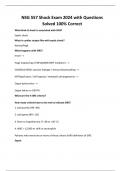
-
NSG 557 Shock Exam 2024 with Questions Solved 100% Correct
- Exam (elaborations) • 7 pages • 2024
- Available in package deal
-
- $12.49
- + learn more
What kind of shock is associated with SIRS? Septic shock What is cardiac output like with septic shock? Normal/high What happens with SIRS? Insult --> Huge outpouring of INFLAMMATORY mediators --> VASODILATION/ vascular leakage / venous blood pooling --> HYPOperfusion / cell hypoxia / metabolic derangements --> Organ dysfunction --> Organ failure or DEATH
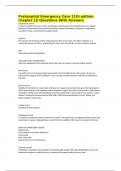
-
Prehospital Emergency Care 11th edition chapter 15 Questions With Answers
- Exam (elaborations) • 9 pages • 2024
-
- $10.09
- + learn more
Prehospital Emergency Care 11th edition chapter 15 Questions With Answers anaphylactic shock A severe reaction that occurs when an allergen is introduced to the bloodstream of an allergic individual. Characterized by bronchoconstriction, labored breathing, widespread vasodilation, circulatory shock, and sometimes sudden death. Asystole The absence Of electrical activity and pumping action in the heart. This often registers on a monitoring screen as a flat or nearly flat line; hence the t...
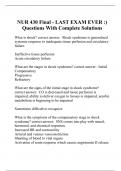
-
NUR 430 Final - LAST EXAM EVER :) Questions With Complete Solutions
- Exam (elaborations) • 40 pages • 2023
-
- $15.99
- + learn more
What is shock? correct answer: Shock syndrome is generalized systemic response to inadequate tissue perfusion and circulatory failure. Ineffective tissue perfusion Acute circulatory failure What are the stages in shock syndrome? correct answer: Initial Compensatory Progressive Refractory What are the signs of the initial stage in shock syndrome? correct answer: CO is decreased and tissue perfusion is impaired, ability to deliver oxygen to tissues is impaired, aerobic metabolism ...
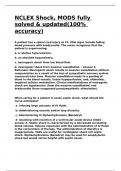
-
NCLEX Shock, MODS fully solved & updated(100% accuracy)
- Exam (elaborations) • 10 pages • 2024
-
- $16.49
- + learn more
A patient has a spinal cord injury at T4. Vital signs include falling blood pressure with bradycardia. The nurse recognizes that the patient is experiencing: a. a relative hypervolemia. b. an absolute hypovolemia. c. neurogenic shock from low blood flow. d. neurogenic shock from massive vasodilation. d Rationale: Neurogenic shock results in massive vasodilation without compensation as a result of the loss of sympathetic nervous system vasoconstrictor tone. Massive vasodilation leads to a po...
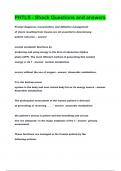
-
PHTLS - Shock Questions and answers
- Exam (elaborations) • 15 pages • 2024
- Available in package deal
-
- $14.49
- + learn more
Prompt diagnosis, resuscitation, and definitive management of shock resulting from trauma are all essential in determirung patient outcome. normal metabolic functions by producing and using energy in the form of adenosine triphos phate (ATP). The most efficient method of generating this needed energy is via ? aerobic metabolism occurs without the use of oxygen Anaerobic metabolism, It is the backup power system in the body and uses stored body fat as its energy sourc...
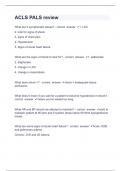
-
ACLS PALS review Questions with complete solution
- Exam (elaborations) • 6 pages • 2024
-
Available in package deal
-
- $14.49
- + learn more
ACLS PALS review Questions with complete solution ACLS PALS review What are 5 symptomatic issues? - correct answer 1. LOC 2. look for signs of shock 3. signs of chest pain 4. Hypotension 5. Signs of acute heart failure What are the signs of shock to look for? - correct answer 1. pallor/pale 2. diaphoretic 3. change in LOC 4. change in respirations What does shock =? - correct answer shock = inadequate tissue perfussion What does it mean if you wait for a patient to becom...
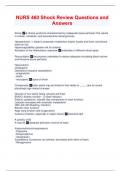
-
NURS 460 Shock Review Questions and Answers
- Exam (elaborations) • 5 pages • 2024
-
Available in package deal
-
- $8.99
- + learn more
Shock A clinical syndrome characterized by inadequate tissue perfusion that results in cellular, metabolic, and hemodynamic derangements. Hypoperfusion -> leads to anaerobic metabolism (higher lactate acid level, send blood down on ice) Hypercoagulability (greater risk for clotting) Activation of the inflammatory response similarities of different shock types Resuscitation the process undertaken to restore adequate circulating blood volume and therefore tissue perfusion Hypovolemic Cardiog...
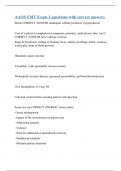
-
AAOS EMT Exam 2 questions with correct answers
- Exam (elaborations) • 10 pages • 2023
- Available in package deal
-
- $15.99
- + learn more
Shock CORRECT ANSWER inadequate cellular perfusion; hypoperfusion Care of a patient in anaphylaxis (symptoms, priorities, medications, other care?) CORRECT ANSWER Sever allergic reaction Signs & Symptoms: itching or burning, hives, edema (swelling), pallor, cyanosis, weak pulse, drop in blood pressure Histamine causes reaction Vasodilate, walls permeable, airways restrict Widespread vascular dilation, increased permeability, and bronchoconstriction Give Epinephrine: 0.3 mg, IM ...

$6.50 for your textbook summary multiplied by 100 fellow students... Do the math: that's a lot of money! Don't be a thief of your own wallet and start uploading yours now. Discover all about earning on Stuvia


